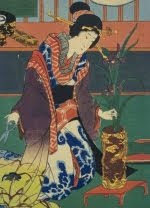Goat Willow (Salix caprea), Eustoma, Spirea.
Kabuwake freestyle.
Kabuwake freestyle.
Did you ever notice that branches of Goat Willow can have a quite strong colour? I was so surprised by the shiny yellow and red branches coming up from the base of an old tree, that had been taken down. The shape of these young branches varies from straight to slightly bent and elegantly curved.
I used these branches together with some other spring materials to illustrate the difference between the basic style Variation no. 5 and Free style kabuwake. The word kabuwake, meaning 'separated groups', is used for Variation no. 5 as well. In both styles the materials are divided into to distinct groups. These kind of arrangements build on the traditions from very old Rikka arrangements, that were splitt in the middle with two shin (main) lines, or just two groups allowing water two flow in between them as a fish path.
Variation no. 5 moribana kabuwake is a basic style with fixed rules for the lengths and placements of the branches. The two groups represents an arrangement that have been taken apart and divided into two parts, that are incomplete without each other. The open water surface between the two groups is the most important feature of this arrangement. The kabuwake freestyle is a freestyle arrangement that has been developed from Variation no. 5. The expression is freer and the arrangement more vertical. The open space on the water surface continues up between the branches, and creates a powerful open space full of energy.
I used these branches together with some other spring materials to illustrate the difference between the basic style Variation no. 5 and Free style kabuwake. The word kabuwake, meaning 'separated groups', is used for Variation no. 5 as well. In both styles the materials are divided into to distinct groups. These kind of arrangements build on the traditions from very old Rikka arrangements, that were splitt in the middle with two shin (main) lines, or just two groups allowing water two flow in between them as a fish path.
Variation no. 5 moribana kabuwake is a basic style with fixed rules for the lengths and placements of the branches. The two groups represents an arrangement that have been taken apart and divided into two parts, that are incomplete without each other. The open water surface between the two groups is the most important feature of this arrangement. The kabuwake freestyle is a freestyle arrangement that has been developed from Variation no. 5. The expression is freer and the arrangement more vertical. The open space on the water surface continues up between the branches, and creates a powerful open space full of energy.
Goat Willow (Salix caprea), Eustoma, Spirea.
Variation no. 5, moribana.
Variation no. 5, moribana.























